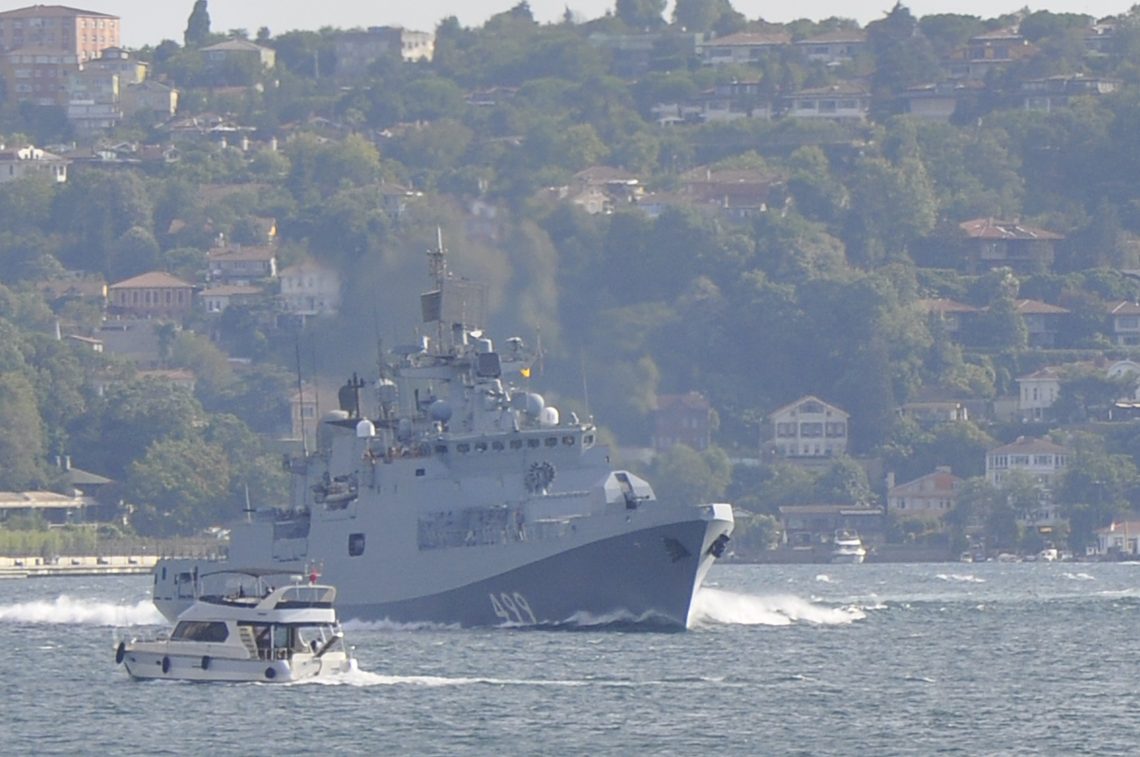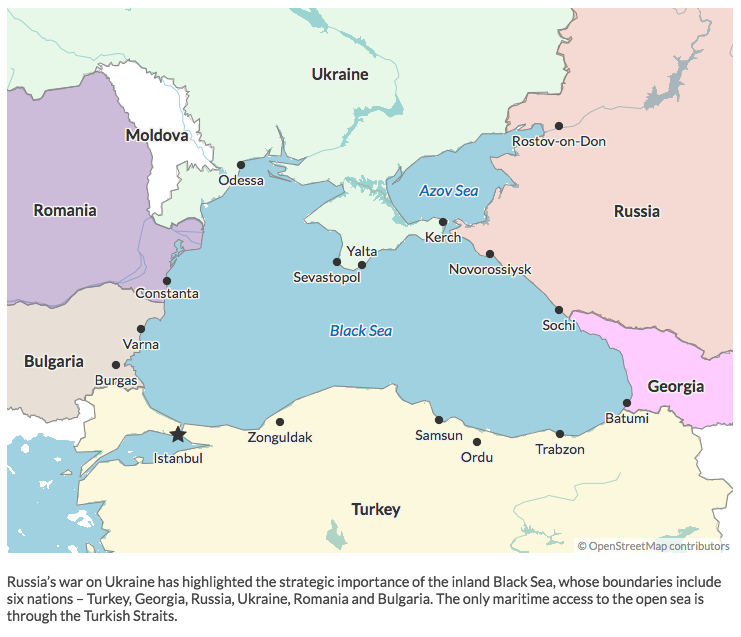Who will control the Black Sea?
Moscow’s wartime blockades of Ukraine are prompting calls for stronger protection of navigation and revisions to a key agreement regulating the passage of ships.

In a nutshell
- Turkey controls access of warships entering from the Mediterranean
- The Volga-Don Canal allows Russia to move ships from the Caspian Sea
- Romania, Bulgaria and even Turkey seek a stronger NATO presence
Wars have been fought for centuries over command of the Black Sea. Controlling the comings and goings of vessels in this vast inland waterway, with a surface area of 436,400 square kilometers, is key to securing that power.
Throughout history, geography has given the Ottoman Empire and later Turkey major influence in this region. The Ottoman Empire, which lasted from 1299 to 1922, controlled two major straits – the Dardanelles, which runs from the Sea of Marmara to the Aegean Sea – as well as the Bosporus, which runs from the Black Sea to the Sea of Marmara. Collectively, they are known as the Turkish Straits, or simply “the Straits,” and provide the only entry to the Black Sea from the Mediterranean Sea. Upon the conquest of Crimea in 1475, the Ottoman Empire excluded all foreign ships from the Black Sea, effectively creating a “Turkish lake” for three centuries.
1923 Treaty of Lausanne
Ottoman dominance of the Black Sea ended in 1774 after an ill-fated decision to join Poland in a war against Russia. Catherine the Great secured Crimea as a Russian protectorate as well as freedom of passage through the Straits for its commercial shipping. The question of the Straits remained subject to the ebb and flow of great powers over the years. But the “ancient rule” of keeping the Straits closed to all warships continued until the Treaty of Lausanne in 1923, only a year after the Soviet Union came into existence. The treaty laid down the principle of the freedom of passage for all vessels – even warships, but only during times of peace. It also set up an International Straits Commission to supervise the various provisions of the treaty, which included demilitarization.
By 1931, Turkey was increasingly concerned that the Lausanne Treaty’s demilitarization clause was incompatible with Turkey’s legitimate right of self-defense. The collective security system envisioned by the League of Nations began to disintegrate after Germany remilitarized and Italy invaded Abyssinia, now Ethiopia. This fundamental change in circumstance allowed Turkey to reopen the issue of the Straits at a conference in Montreux, Switzerland.
1936 Montreux Convention
Soviet Russia sought to make the Black Sea closed to all except the littoral states. Ukraine and Georgia were then part of the Soviet Union, while Romania and Bulgaria were Soviet allies. The United Kingdom and others wanted to limit the ability of Soviet warships to enter and exit the Mediterranean at will and then take refuge in the Black Sea if pursued by enemies. The UK also sought oversight of Turkey’s ability to close the Straits. These views were opposed by Russia and Turkey, while the United States was in its isolationist phase and did not take part. The resulting 1936 Montreux Convention allowed Turkey to remilitarize and once again control the Straits, which were firmly under its sovereignty. But the agreement regulating the passage of ships also assured Soviet dominance in the Black Sea.
Also by Colleen Graffy
Who will own the oceans?
Stalin’s pressure prompts Turkey to join NATO
Although the overall result was advantageous for the Soviet Union, Joseph Stalin was not satisfied. At the Potsdam Conference in 1945, Stalin raised the issue of revising the Montreux Convention. It was agreed that the “Three Powers” (the Soviet Union, the UK and the U.S.) would take up the issue with the Turkish government. But Soviet pressure on Turkey to give up territory and agree to joint control over the Straits pushed Turkey into joining NATO in 1952.
Contrary to international law, Russia blocked freedom of navigation in the inland Sea of Azov and the right to innocent passage in Ukraine’s territorial waters off Crimea.
Russian dominance in the Black Sea began to unravel after the breakup of the Soviet Union. Bulgaria and Romania joined NATO in 2004. Georgia declared its independence and looked to the West for its future, prompting Russia to invade in 2008. The Kremlin seized control of inland South Ossetia and coastal Abkhazia. Moscow occupies both Georgian regions today. Russia and Ukraine divided the Black Sea Fleet and, in a deal with Ukraine’s Kremlin-backed President Viktor Yanukovych, Moscow renewed its lease on the Crimean naval base until at least 2042. But the pro-Western revolution that drove Mr. Yanukovych from power angered Russia, which invaded and quickly annexed the peninsula in 2014. The international community largely does not recognize the illegal land grab. That same year Moscow took control of parts of the Donbas region in eastern Ukraine after sending in troops. Russia also began to rebuild its navy, which had been in decline for many years.
Facts & figures
Black Sea riparian vessels have significant rights and privileges over foreign vessels.
Foreign warships may not remain in the Black Sea longer than 21 days. Black Sea navies are exempt from these restrictions.
Non-Black Sea navies have a permissible aggregate tonnage of 45,000 tons and no one non-Black Sea power may have more than two-thirds of that number.
Warships of belligerent states “shall not […] pass through the Straits” except if a) one of the belligerents is acting under lawful collective defense rights obligations that Turkey is also a party to or b) any belligerent warship must pass through the Straits to return to its base. Russian Black Sea Fleet warships deployed outside the Black Sea were allowed to return through the Straits, but Russia cannot transfer warships through the Straits until the end of hostilities. This means Moscow cannot replace any destroyed vessels, such as the Moskva.
A ‘Russian lake’ takes shape
Russia’s full-scale invasion of Ukraine, launched on February 24, 2022, put Moscow’s increasingly assertive behavior into sharp focus: the Black Sea had become a “Russian lake.” Contrary to international law, Russia blocked freedom of navigation in the inland Sea of Azov and the right to innocent passage in Ukraine’s territorial waters off Crimea. The Volga-Don Canal allows Russia to move ships from the Caspian Sea to the Sea of Azov and then south into the Black Sea through the Kerch Strait. After securing the Port of Tartus in an agreement with Syria, Russia gained its long-sought warm water port along with unimpeded access into and out of the Mediterranean from the Black Sea. If the Kremlin proves successful in its illegal invasion of Ukraine, an emboldened Russia will likely seek to annex Transnistria, a Russian-backed enclave in Moldova, and expand its territory throughout Ukraine, and possibly Romania, to the Black Sea.
The current reality is that the Montreux Convention gives one power, Russia, the ability to dominate the Black Sea and threaten, attack and occupy coastal states.
Romania, Bulgaria and even Turkey have encouraged a stronger U.S. and NATO presence in the Black Sea, but the lack of ships, resources and strategy has prevented the West from taking a stronger stand. As a response to Russian aggression, U.S. Senators Jeanne Shaheen and Mitt Romney have introduced legislation that would require the U.S. to advance a Black Sea security and development strategy. This could include the establishment of a NATO maritime headquarters there. The aim of the Montreux Convention was to prevent great power competition and armed conflict by controlling the entry and exit and size of warships in the Black Sea. While it was established to provide security and stability for the region, in the current reality it gives one power, Russia, the ability to dominate the Black Sea and threaten, attack and occupy coastal states. Russia’s maneuverings have undermined the goal of the Montreux Convention, and some believe it is time to end or update the treaty.
Special rights for Turkey, Russia
The Montreux provisions stand in stark contrast to the principles of free military seafaring in the waters of the open sea established centuries earlier. The “special rights” for Black Sea countries now extend, effectively, only to Russia and Turkey. These privileges run contrary to modern principles of international sea law, in the view of many critics. The 1982 United Nations Convention on the Law of the Sea (UNCLOS) provides for the right of transit passage through international straits (Article 38). Ending the treaty could revert the region to the law of the sea norms that are followed by most nations.
The “Three Powers” at Potsdam identified updates to the treaty that were already needed in 1945, such as substituting the “United Nations Organization” for the “League of Nations,” and removing Japan from the signatory powers. The U.S. suggested that passage through the Straits should be forbidden to war vessels belonging to non-Black Sea nations, “except with the consent of the Black Sea powers or in the execution of a mission under the authority of the United Nations.” This would be an important rebalancing provision if it is ever enacted. Georgia and Ukraine are not officially parties to the convention, as Montreux was signed by the Soviet Union, and Russia is the sole successor state. As littoral Black Sea states, however, both countries should clearly be included.
Other revisions needed
The Montreux Convention also needs revision to accommodate the increase in size, weight, and capabilities of modern warships. After the Russian invasion of Georgia in 2008, Turkey refused the passage of U.S. hospital ships USNS Mercy and USNS Comfort because they were U.S. Navy vessels and would violate Montreux size limits. Russia currently does not have the same limits on tonnage as non-littoral states.
To comply with the rolling five-year deadline set out in the convention, any such amendments must be submitted by August 2026 for a new treaty to be agreed upon by November 9, 2026.
Scenarios
In the first possible scenario, fissures emerge within NATO countries and the European Union, and disunity weakens sanctions against Russia and weapon supplies to Ukraine. Russian aggression against Ukraine carries on and Russia continues to stretch aspects of the Montreux Convention to its advantage, such as by deploying its Black Sea submarines in the Mediterranean, which is not allowed, while officially claiming they are in transit to or from shipyards for repair. Russia also continues to violate other aspects of international law in the Black Sea, such as preventing the right of innocent passage through Ukraine’s Crimean territorial waters, cutting off access to the Sea of Azov by blocking transit through the Kerch Strait and blockading food and energy supplies. Emboldened, Russia eyes further territorial gains to be had around the Black Sea and increased ways to enhance its power projection into the eastern and central Mediterranean.
Under this scenario, the 1936 Montreux Convention remains unchanged. The Black Sea continues as a “Russian lake.” The recent successes realized by Ukrainian counteroffensives against Russia and signs of a possible collapse of the Russian Army now make this a less likely scenario.
In the second scenario, Russia is defeated in its aggression against Ukraine but there is no political will or leadership to redraft the Montreux Convention. This scenario has a moderate level of likelihood.
In the third scenario, Russia is defeated in its aggression against Ukraine and the U.S., EU, NATO, and Black Sea states feel empowered to redraft the Montreux Convention to restore and ensure long-term stability and security in the region. Amendments are put forward to update and modernize the Montreux Convention, leaving Turkey’s sovereignty and control over the Straits intact. This scenario has a moderate level of likelihood, which would rise if the Shaheen-Romney bill passes.
In the fourth scenario, the Turkish Straits are no longer treated as a separate legal regime under the Montreux Convention but fall under the rules on international straits as set out in the United Nations Convention on the Law of the Sea. This scenario is highly unlikely given Turkish resistance to any encroachment on its sovereignty.









